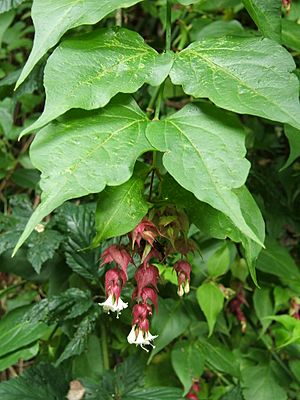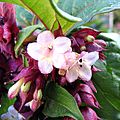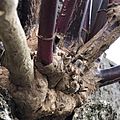Pheasant berry facts for kids
Quick facts for kids Pheasant berry |
|
|---|---|
 |
|
| Scientific classification | |
| Genus: |
Leycesteria
|
| Species: |
formosa
|
The Leycesteria formosa, also known as the pheasant berry, is a type of shrub that loses its leaves in winter. It belongs to the Caprifoliaceae family, which also includes honeysuckles. This plant originally comes from the Himalayas and southwestern China.
However, in places like Australia, New Zealand, and some nearby islands, it's considered an invasive species. This means it can grow too much and harm local plants. In its home region, the Himalayas, people have used this shrub for a long time in their traditional medicines.
Contents
What's in a Name?
The name Leycesteria was given by a scientist named Nathaniel Wallich around 1820. He named it after his friend, William Leycester, who was a judge and loved gardening. The second part of the name, formosa, comes from Latin and means 'beautiful' or 'handsome'. This refers to its unique, hanging flowers and their pretty, wine-colored leaves (called bracts) that grow around them.
Some people mistakenly think formosa means it comes from the island of Taiwan, which was once called Formosa. But the name is simply about the plant's beauty, not its origin from that island.
This plant has many other common names too! People call it Himalayan honeysuckle, pheasant-eye, Elisha's tears, flowering nutmeg, spiderwort, Cape fuchsia, whistle stick, Himalaya nutmeg, granny's curls, partridge berry, chocolate berry, shrimp plant/flower and treacle tree/berry. Even with these names, it's not related to the nutmeg tree or the fuchsia plant.
Plant Family Connections
Scientists have studied the genes of Leycesteria and found it's closely related to two other plant groups: Triosteum (also called "horse gentians") and Heptacodium (known as "seven son flower").
These three groups are part of the Caprifolioideae subfamily. This subfamily also includes the true honeysuckles (Lonicera) and the snowberries (Symphoricarpos).
Plant Description
The pheasant berry is a shrub that can be 1 to 3 meters (about 3 to 10 feet) tall. Its young stems are soft, hollow, and stand upright. They can be green, pink, maroon, or purple. These stems usually last only 2 to 5 years before new ones grow from the roots. Older plants might have short, woody trunks with rough, grey bark at the bottom.
Its leaves are dark green and heart-shaped, about 6 to 18 cm (2.4 to 7 inches) long. They often have a wavy edge and a pointed tip, which helps water drip off in wet places.
The flowers are small and grow in hanging bunches that are 5 to 10 cm (2 to 4 inches) long. They can be white, pale pink, or sometimes deep purplish-pink. Each flower has a purplish-pink leaf (bract) underneath it.
The plant produces berries that are hard and deep pink when they are not ripe. When they are ripe, they become soft, fragile, and a deep purple-brown color, about 1 cm (0.4 inches) across. Birds love to eat these berries, which helps spread the seeds.
When unripe, the berries taste bitter. But when they are soft and dark purple-brown, they are sweet and edible. They have a mild taste, a bit like toffee or caramel.
Where Does it Grow?
The Leycesteria formosa is found naturally in many places. Its native home includes Pakistan, India, Nepal, the East and West Himalayas, and southwestern China (Sichuan, Yunnan, and Guizhou provinces), Tibet, and Myanmar.
It grows well in wet, rocky forests and on cliffs. This explains why it can also grow on walls, which are like artificial cliffs! This plant is also tough against air pollution and can handle windy places and salty air near the coast. Deer usually don't eat it. You can often find it growing wild in southern England and along roadsides and riverbanks in Ireland.
Medicinal Uses
In Southwest China, Leycesteria formosa is a popular medicinal plant called Yi Yao. The Yi people in Sichuan province use the young shoots of the plant in their traditional medicine to treat measles.
In the Poonch region of Pakistan and the Kedarnath Wildlife Sanctuary in India, people use a paste from the leaves to treat dandruff and lice in hair.
The Monpa people in Tibet use parts of the plant to stop bleeding from injuries. They also use it to help with bone fractures.
In Nepal, some people use parts of the plant to treat worms.
Traditional Chinese Medicine
In Chinese, one common name for Leycesteria formosa is 鬼吹簫 (Guĭ chuī xiāo), which means ghost flute. This name comes from the spooky, flute-like sounds the hollow stems make when the wind blows through them.
In traditional Chinese medicine, this plant is believed to help remove "dampness" and "heat" from the body. It's also thought to improve blood flow and stop bleeding. People use it to treat conditions like jaundice, arthritic pain, asthma, irregular menstruation, bladder infections, and bone fractures. This plant has been used in China for thousands of years as an important medicine.
Why "Ghost Flute"?
The name "ghost flute" (and "ghost bamboo") comes from the eerie sounds the plant's hollow, broken stems make in the wind. Imagine walking in the countryside at night, and you hear a flute playing, but there's no one there! People in ancient times might have felt a bit scared, thinking ghosts were playing the music. But once they understood how the hollow stems made the sound, they realized there was nothing to be afraid of.
Other Chinese names for the plant often refer to its hollow, tube-like stems, which look like bamboo or can be used to make wind instruments. Some names even suggest that the jointed stems pop or crack like firecrackers when burned, similar to bamboo.
Other Uses
The hollow stems of Leycesteria formosa have been used in India to make whistles and flutes. In North India, people also use the plant as a natural fertilizer for soil and as firewood.
Is it Safe?
Many sources say that Leycesteria formosa is not harmful. However, there have been reports of cattle deaths in New Zealand and Australia linked to the plant. Because of this, it's best to be careful. The leaves and unripe berries are likely the parts that animals might eat.
Plant Chemistry
Scientists have found special chemicals in Leycesteria formosa, including compounds called coumarins and flavonoids. Some of these chemicals, like amentoflavone, are being studied for their possible use in treating skin conditions like dermatitis.
Gallery


























